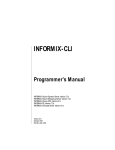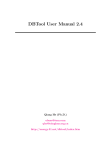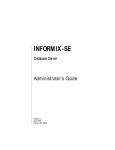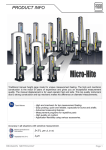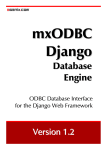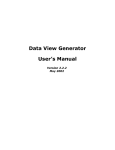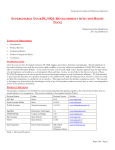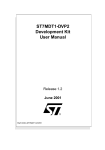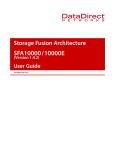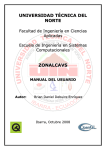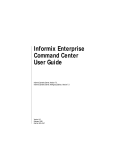Download INTERSOLV DataDirect ODBC Driver User Guide
Transcript
INTERSOLV DataDirect ODBC Driver ® User Guide for Informix Database Servers INFORMIX-OnLine Dynamic Server, Version 7.2x INFORMIX-OnLine Workgroup Server, Version 7.2x INFORMIX-OnLine XPS, Version 8.1x INFORMIX-SE, Version 7.2x INFORMIX-Universal Server, Version 9.1x Version 3.01 October 1997 Part No. 000-4169 ® Published by INFORMIX Press Informix Software, Inc. 4100 Bohannon Drive Menlo Park, CA 94025 Copyright 1981-1997 by Informix Software, Inc. or their subsidiaries, provided that portions may be copyrighted by third parties, as set forth in documentation. All rights reserved. The following are worldwide trademarks of Informix Software, Inc., or its subsidiaries, registered in the United States of America as indicated by “,” and in numerous other countries worldwide: INFORMIX; INFORMIX-OnLine Dynamic Server; DataBlade The following are worldwide trademarks of Informix Software, Inc., or its subsidiaries, registered in the United States of America as indicated by “,” and in numerous other countries worldwide: Adobe Systems Incorporated: PostScript INTERSOLV, Inc.: DataDirect; INTERSOLV; PVCS Microsoft Corporation: ODBC; Windows NT; Windows 95 X/Open Company Ltd.: UNIX All other marks or symbols are registered trademarks or trademarks of their respective owners. Documentation Team: Twila Booth, Jennifer Leland, Jonathan Newman To the extent that this software allows the user to store, display, and otherwise manipulate various forms of data, including, without limitation, multimedia content such as photographs, movies, music and other binary large objects (blobs), use of any single blob may potentially infringe upon numerous different third-party intellectual and/or proprietary rights. It is the user's responsibility to avoid infringements of any such thirdparty rights. RESTRICTED RIGHTS/SPECIAL LICENSE RIGHTS Software and documentation acquired with US Government funds are provided with rights as follows: (1) if for civilian agency use, with Restricted Rights as defined in FAR 52.227-19; (2) if for Dept. of Defense use, with rights as restricted by vendor's standard license, unless superseded by negotiated vendor license as prescribed in DFAR 227.7202. Any whole or partial reproduction of software or documentation marked with this legend must reproduce the legend. ii INTERSOLV DataDirect ODBC Driver User Guide for Informix Database Servers Table of Contents Table of Contents Introduction About This Manual . . . . . . . . . . Types of Users . . . . . . . . . . Software Dependencies . . . . . . . Demonstration Database . . . . . . Documentation Conventions . . . . . . Typographical Conventions . . . . . Icon Conventions . . . . . . . . . Screen-Illustration Conventions . . . . Additional Documentation . . . . . . . On-Line Manuals . . . . . . . . . Printed Manuals . . . . . . . . . Error Message Files . . . . . . . . Documentation Notes and Release Notes . Compliance with Industry Standards . . . Informix Welcomes Your Comments . . . . Chapter 1 . . . . . . . . . . . . . . . . . . . . . . . . . . . . . . . . . . . . . . . . . . . . . . . . . . . . . . . . . . . . . . . . . . . . . . . . . . . . . . . . . . . . . . . . . . . . . . . . . . . . . . . . . . . . . . . . . . . . . . . . 3 3 4 4 5 5 6 8 8 8 8 9 9 10 10 About INTERSOLV DataDirect ODBC Driver 3.01 . . . Support for Multiple Environments. . . . . . . Installing the INTERSOLV DataDirect ODBC Driver . Environment-Specific Information . . . . . . . . For Windows 95 and Windows NT Users . . . . . For UNIX Users . . . . . . . . . . . . . Error Messages . . . . . . . . . . . . . . . . . . . . . . . . . . . . . . . . . . . . . . . . . . . 1-3 1-4 1-4 1-4 1-4 1-5 1-7 Getting Started Chapter 2 INTERSOLV DataDirect ODBC Driver Configuration and Reference System Requirements for Windows 95 and Windows NT . . . . System Requirements for UNIX . . . . . . . . . . . . . Configuring Data Sources . . . . . . . . . . . . . . . Using a Logon Dialog Box to Connect to a Data Source . . . . . Using a Connection String to Connect to a Data Source . . . . . Data Types . . . . . . . . . . . . . . . . . . . . Isolation and Lock Levels Supported . . . . . . . . . . . ODBC Conformance Level . . . . . . . . . . . . . . . ODBC API and Scalar Functions . . . . . . . . . . . . . API Functions . . . . . . . . . . . . . . . . . . Scalar Functions . . . . . . . . . . . . . . . . . Number of Connections and Statements Supported . . . . . . Index iv INTERSOLV DataDirect ODBC Driver User Guide for Informix Database Servers 2-3 2-4 2-5 2-10 2-11 2-14 2-16 2-17 2-17 2-17 2-20 2-28 Introduction Introduction About This Manual . . . . Types of Users . . . . Software Dependencies . Demonstration Database . . . . . . . . . . . . . . . . . . . . . . . . . . . . . . . . . . . . . . . . . . . . . . . . . . . . . . . . . . . . 3 3 4 4 . . . . . . . . . . . . . . . . . . . . . . . . . . . . . . . . . . . . . . . . . . . . . . . . . . . . . . . . . . . . 5 5 6 6 7 8 Additional Documentation . . . . . . . On-Line Manuals . . . . . . . . . Printed Manuals . . . . . . . . . Error Message Files . . . . . . . . Documentation Notes and Release Notes . . . . . . . . . . . . . . . . . . . . . . . . . . . . . . . . . . . . . . . . . . . . . . 8 8 8 9 9 Compliance with Industry Standards . . . . . . . . . . . . 10 Informix Welcomes Your Comments . . . . . . . . . . . . . 10 Documentation Conventions . . . . . Typographical Conventions . . . . Icon Conventions . . . . . . . . Comment Icons . . . . . . . Feature, Product, and Platform Icons Screen-Illustration Conventions . . . 2 INTERSOLV DataDirect ODBC Driver User Guide for Informix Database Servers R ead this introduction for an overview of the information provided in this manual and for an understanding of the documentation conventions used. About This Manual This guide describes how to use INTERSOLV DataDirect ODBC Driver to access an Informix database and interact with an Informix database server. Types of Users This manual is for C programmers who are using INTERSOLV DataDirect ODBC Driver to access Informix relational databases. This manual assumes that you know C programming and are familiar with the structure of relational databases. If you have limited experience with relational databases, SQL, or your operating system, see the Getting Started manual for your database server for a list of supplementary manuals. Introduction 3 Software Dependencies Software Dependencies This manual assumes that you are using INTERSOLV DataDirect ODBC Driver, Version 3.01, on either a Windows NT, Windows 95, or UNIX platform. In addition, you must use one of the following Informix database servers: ■ INFORMIX-OnLine Dynamic Server, Version 7.2x ■ INFORMIX-OnLine Workgroup Server, Version 7.2x ■ INFORMIX-OnLine XPS, Version 8.1x ■ INFORMIX-SE, Version 7.2x ■ INFORMIX-Universal Server, Version 9.1x Demonstration Database The DB-Access utility, which is provided with your Informix database server products, includes a script to build a demonstration database called stores7 that contains information about a fictitious wholesale sporting-goods distributor. Sample command files are also included. Some database server software allows you to build other demonstration databases as well. Many examples in Informix manuals are based on the stores7 demonstration database. For more information about installing stores7, see the DB-Access User Manual for your database server. 4 INTERSOLV DataDirect ODBC Driver User Guide for Informix Database Servers Documentation Conventions Documentation Conventions This section describes the following conventions: ■ Typographical conventions ■ Icon conventions ■ Screen-illustration conventions Typographical Conventions This manual uses the following standard set of conventions to introduce new terms, illustrate screen displays, describe command syntax, and so forth. Convention Meaning KEYWORD All keywords appear in uppercase letters in a serif font. italics Within text, new terms and emphasized words appear in italics. Within syntax diagrams, values that you are to specify appear in italics. boldface Identifiers (names of classes, objects, constants, events, functions, program variables, forms, labels, and reports), environment variables, database names, filenames, table names, column names, icons, menu items, command names, and other similar terms appear in boldface. monospace Information that the product displays and information that you enter appear in a monospace typeface. KEYSTROKE Keys that you are to press appear in uppercase letters in a sans serif font. ♦ This symbol indicates the end of feature-, product-, platform-, or compliance-specific information. ➞ This symbol indicates a menu item. For example, “Choose Tools➞Options” means choose the Options item from the Tools menu. Introduction 5 Icon Conventions Tip: When you are instructed to “enter” characters or to “execute” a command, immediately press RETURN after the entry. When you are instructed to “type” the text or to “press” other keys, no RETURN is required. Icon Conventions Throughout the documentation, you will find text that is identified by several different types of icons. This section describes these icons. Comment Icons Comment icons identify warnings, important notes, or tips. This information is always displayed in italics. Icon Description The warning icon identifies vital instructions, cautions, or critical information. The important icon identifies significant information about the feature or operation that is being described. The tip icon identifies additional details or shortcuts for the functionality that is being described. 6 INTERSOLV DataDirect ODBC Driver User Guide for Informix Database Servers Icon Conventions Feature, Product, and Platform Icons Feature, product, and platform icons identify paragraphs that contain feature-, product-, or platform-specific information. Icon Description GLS Identifies information that is specific to the Informix Global Language Support (GLS) feature. IUS Identifies information that is specific to INFORMIX-Universal Server. ODS Identifies information that is specific to INFORMIX-OnLine Dynamic Server. OWS Identifies information that is specific to INFORMIX-OnLine Workgroup Server. SE UNIX Identifies information that is specific to INFORMIX-SE. Identifies information that is specific to the UNIX operating system. WIN NT Identifies information that is specific to the Windows NT environment. WIN 95 Identifies information that is specific to the Windows 95 environment. WIN NT/95 Identifies information that is specific to both Windows NT and Windows 95 environments. XPS Identifies information that is specific to INFORMIX-OnLine XPS. These icons can apply to a row in a table, one or more paragraphs, or an entire section. A ♦ symbol indicates the end of the feature-, product-, or platformspecific information. Introduction 7 Screen-Illustration Conventions WIN NT/95 Screen-Illustration Conventions The illustrations in this manual represent a generic rendition of various windowing environments. The details of dialog boxes, controls, and windows were deleted or redesigned to provide this generic look. Therefore, the illustrations in this manual depict the graphical interface of your product a little differently than the way it appears on your screen.♦ Additional Documentation For additional information, you might want to refer to the following types of documentation: ■ On-line manuals ■ Printed manuals ■ Error message files ■ Documentation notes and release notes ■ Related reading On-Line Manuals An Answers OnLine CD that contains Informix manuals in electronic format is provided with your Informix products. You can install the documentation or access it directly from the CD. For information about how to install, read, and print on-line manuals, see the installation insert that accompanies Answers OnLine. Printed Manuals To order printed manuals, call 1-800-331-1763 or send email to [email protected]. When you place an order, please provide the following information: 8 ■ The documentation that you need ■ The quantity that you need ■ Your name, address, and telephone number INTERSOLV DataDirect ODBC Driver User Guide for Informix Database Servers Error Message Files Error Message Files Informix software products provide ASCII files that contain all of the Informix error messages and their corrective actions. The finderr utility displays these error messages on the screen. See the Introduction to the Informix Error Messages manual for a detailed description of these error messages. UNIX WIN NT/95 To read the error messages in the ASCII file, Informix provides scripts that let you display error messages on the screen (finderr) or print formatted error messages (rofferr). For a detailed description of these scripts, see the Introduction to the Informix Error Messages manual.♦ Informix Find Error is a graphical tool. This utility has been created with Microsoft help facilities. For more information, see the Introduction to the Informix Error Messages manual.♦ Documentation Notes and Release Notes In addition to printed documentation, the following on-line files supplement the information in this manual. For UNIX, these files are located in the $INFORMIXDIR/release/en_us/0333 directory. For Windows, these files are located in the $INFORMIXDIR\release\en_us\04e4 directory. On-Line File Purpose ODBCDOC_3.0 The documentation-notes file describes features that are not covered in this manual or that have been modified since publication. For Windows, click the Documentation Notes icon. CLIENTS_2.0 The CLIENTS_2.0 file lists the release-notes files for the 2.0 Client SDK. These release-notes files describe feature differences from earlier versions of Informix products and how these differences might affect current products. These files also contain information about any known problems and their workarounds. For Windows, click the Release Notes icon. Please examine these files because they contain vital information about application and performance issues. Introduction 9 Compliance with Industry Standards Compliance with Industry Standards INTERSOLV DataDirect ODBC Driver is based on Version 3.0 of the Microsoft Open Database Connectivity specification, which in turn is based on the X/Open Group SQL Access Call-Level Interface (CLI) specification. The ODBC and CLI specifications provide a common and open interface through which ANSI-compliant SQL is passed. Informix Welcomes Your Comments Please tell us what you like or dislike about our manuals. To help us with future versions of our manuals, we want to know about corrections or clarifications that you would find useful. Include the following information: ■ The name and version of the manual that you are using ■ Any comments that you have about the manual ■ Your name, address, and phone number Write to us at the following address: Informix Software, Inc. SCT Technical Publications Department 4100 Bohannon Drive Menlo Park, CA 94025 If you prefer to send email, our address is: [email protected] Or send a facsimile to the Informix Technical Publications Department at: 650-926-6571 We appreciate your feedback. 10 INTERSOLV DataDirect ODBC Driver User Guide for Informix Database Servers Chapter Getting Started 1 About INTERSOLV DataDirect ODBC Driver 3.01 . . . Support for Multiple Environments . . . . . . . Installing the INTERSOLV DataDirect ODBC Driver . . . . . . . . . . . . . . . . 1-3 1-4 1-4 Environment-Specific Information . . . . . . . For Windows 95 and Windows NT Users . . . . Starting the ODBC Administrator . . . . . Driver Name . . . . . . . . . . . . Disk Space and Memory Requirements . . . For UNIX Users . . . . . . . . . . . . .odbc.ini . . . . . . . . . . . . . . Driver Name . . . . . . . . . . . . Setting the Library Path Environment Variable Disk Space and Memory Requirements . . . . . . . . . . . . . . . . . . . . . . . . . . . . . . . . . . . . . . . . . . . . . . . . . . . . . . . . . . . . . . . 1-4 1-4 1-5 1-5 1-5 1-5 1-5 1-6 1-6 1-6 Error Messages . . . . . . . 1-7 . . . . . . . . . . . . . 1-2 INTERSOLV DataDirect ODBC Driver User Guide for Informix Database Servers T his chapter contains the following sections: ■ About INTERSOLV DataDirect ODBC Driver 3.01 ■ Environment-specific information ■ Error messages About INTERSOLV DataDirect ODBC Driver 3.01 INTERSOLV DataDirect ODBC Driver is compliant with Version 3.0 of the Open Database Connectivity (ODBC) specification. ODBC is a specification for an application programming interface (API) that enables applications to access multiple database management systems with Structured Query Language (SQL). ODBC permits maximum interoperability where a single application can access many different database management systems. This compliance enables an ODBC developer to develop, compile, and ship an application without targeting a specific type of data source. Users can then add INTERSOLV DataDirect ODBC Driver, which links the application to an Informix database server. Getting Started 1-3 Support for Multiple Environments Support for Multiple Environments INTERSOLV provides the ODBC-compliant INTERSOLV DataDirect ODBC Driver on the Windows 95, Windows NT, and UNIX platforms. For current driver information, see the CLIENTS_2.0 file that is shipped with this release. “Environment-Specific Information” explains the environment-specific differences that you should be aware of when you use INTERSOLV DataDirect ODBC Driver in your operating environment. Installing the INTERSOLV DataDirect ODBC Driver The Setup program installs INTERSOLV DataDirect ODBC Driver. For instructions on how to run the Setup program, see the Informix Client Products Installation Guide for your operating system. Environment-Specific Information The following sections contain information specific to your operating environment, such as filenames and system requirements. Information is provided for Windows 95, Windows NT, and UNIX systems. WIN NT/95 For Windows 95 and Windows NT Users On Windows 95 and Windows NT systems, INTERSOLV DataDirect ODBC Driver is a 32-bit driver. All required network software that your database system vendors supply must be 32-bit compliant. For a list of specific requirements, see “System Requirements for Windows 95 and Windows NT” on page 2-3. 1-4 INTERSOLV DataDirect ODBC Driver User Guide for Informix Database Servers For UNIX Users Starting the ODBC Administrator “Configuring Data Sources” on page 2-5 instructs you to start the ODBC Administrator. To start the ODBC Administrator under Windows 95 or Windows NT, double-click the ODBC icon in the Windows 95 or Windows NT Control Panel. Driver Name The INTERSOLV DataDirect ODBC Driver filenames on Windows 95 and Windows NT is IVINF12.DLL. Disk Space and Memory Requirements Disk space requirements are 15 megabytes of free disk space on the disk drive where Windows 95 or Windows NT is installed. Memory requirements are at least 16 megabytes of memory on Windows 95 and at least 24 megabytes of memory on Windows NT.♦ UNIX For UNIX Users For specific requirements, see “System Requirements for Windows 95 and Windows NT” on page 2-3. .odbc.ini In the UNIX environment, no ODBC Administrator exists. To configure a data source, you must edit the .odbc.ini file, a plain text file that is normally located in the user’s $HOME directory. Use any text editor to define datasource entries in this file, as described in “Using a Connection String to Connect to a Data Source” on page 2-11. A sample file (odbc.ini) is located in the driver installation directory. Getting Started 1-5 For UNIX Users Driver Name INTERSOLV DataDirect ODBC Driver is an ODBC API-compliant dynamic link library, referred to in UNIX as a shared object. On UNIX, the INTERSOLV DataDirect ODBC Driver filename is ivinf12.so. Setting the Library Path Environment Variable You must include the full path to the dynamic link libraries in the environment variable LD_LIBRARY_PATH (on Solaris), LIBPATH (on AIX), and SHLIB_PATH (on HP-UX). For example, if you install INTERSOLV DataDirect ODBC Driver in the system directory /opt/odbc, the fully qualified path for the ODBC Pack is /opt/odbc/lib. During installation, a shell startup script is created and stored in the ODBC directory. This shell script sets up the ODBC environment for you. For C shell users, the shell startup script is called .odbc.csh. This script can be sourced from a user’s own .login script. For example: source /opt/odbc/odbc.csh For Bourne or Korn shell users, the shell startup script is called .odbc.sh. This script can also be sourced from a user’s own .profile script. For example: . /opt/odbc/odbc.sh If you do not include the path /opt/odbc in the environment variable LD_LIBRARY_PATH (on Solaris), LIBPATH (on AIX), and SHLIB_PATH (on HP-UX), your applications are unable to load INTERSOLV DataDirect ODBC Driver dynamically at runtime. Disk Space and Memory Requirements Disk space requirements are 25 megabytes of free disk space on the disk where the UNIX system is installed. Memory requirements are at least 16 megabytes of memory.♦ 1-6 INTERSOLV DataDirect ODBC Driver User Guide for Informix Database Servers Error Messages Error Messages Error messages can come from: ■ an ODBC driver. ■ the Informix database server. ■ the ODBC driver manager. An error reported on an ODBC driver has the following format: [vendor] [ODBC_component] message The ODBC_component is the component in which the error occurred. For example, an error message from the INTERSOLV SQL server driver would look like this: [INTERSOLV] [ODBC SQL Server driver] Invalid precision specified. If you get this type of error, check the last ODBC call that your application made for possible problems or contact your ODBC application vendor. An error that occurs in the data source includes the data-source name, in the following format: [vendor] [ODBC_component] [data_source] message With this type of message, the ODBC_component is the component that received the error from the data source indicated. For example, you might get the following message from an Informix data source: [INTERSOLV] [ODBC Informix driver] [Informix] -0919: specified length too long for CHAR column If you get this type of error, you did something incorrectly with the database server. For more information about this type of error, refer to the Informix Error Messages manual or consult your database administrator. The driver manager is a DLL that establishes connections with INTERSOLV DataDirect ODBC Driver, submits requests to INTERSOLV DataDirect ODBC Driver, and returns results to applications. An error that occurs in the driver manager has the following format: [Informix] [ODBC XXX] message Getting Started 1-7 Error Messages For example, an error from the INTERSOLV DataDirect ODBC Driver manager might look like this: [Informix] [ODBC Driver Manager] Driver does not support this function For more information about this type of error, refer to the Informix Error Messages manual or use the finderr utility for information about a specific error. UNIX UNIX error handling is performed according to the X/Open XPG3 messaging catalog system. Localized error messages are stored in the subdirectory locale/localized_territory_directory/LC_MESSAGES, where localized_territory_directory depends on your language. For instance, German localization files are stored in locale/de/LC_MESSAGES, where de is the locale for German. If localized error messages are not available for your locale, then the error messages will contain message numbers instead of text. For example: [INTERSOLV] [ODBC 20101 driver] 30040 ♦ 1-8 INTERSOLV DataDirect ODBC Driver User Guide for Informix Database Servers Chapter INTERSOLV DataDirect ODBC Driver Configuration and Reference 2 System Requirements for Windows 95 and Windows NT. . . . . . 2-3 System Requirements for UNIX . . . . . . . . . . . . . . 2-4 Configuring Data Sources . . . . . . . . . . . . . . 2-5 Using a Logon Dialog Box to Connect to a Data Source . . . . . . 2-10 Using a Connection String to Connect to a Data Source . . . . . . 2-11 Data Types. . . . . . . . . . . . . . . . . . . . . . . 2-14 Isolation and Lock Levels Supported. . . . . . . . . . . . . 2-16 ODBC Conformance Level . . . . . . . . . . . . . 2-17 . . . . . . . . . . . . . . . . . . . . . . . . . . . . . . . . . . . . . . . . . . . . . . . . . . . . . . . . . . . . . . . . . . . . . . . . . . . . . . . . . . . . . . . . . . . . . . . . . . 2-17 2-17 2-20 2-20 2-23 2-25 2-27 . ODBC API and Scalar Functions API Functions . . . . . Scalar Functions . . . . String Functions . . . Numeric Functions . . Date and Time Functions System Functions. . . . . . Number of Connections and Statements Supported . . . . . . . 2-28 2-2 INTERSOLV DataDirect ODBC Driver User Guide for Informix Database Servers T his chapter contains the following sections: ■ System requirements ■ Configuring data sources ■ Using a Logon dialog box to connect to a data source ■ Using a connection string to connect to a data source ■ Data types ■ Isolation and lock levels supported ■ ODBC conformance level ■ ODBC API and scalar functions INTERSOLV DataDirect ODBC Driver supports multiple connections to Informix database servers Versions 5.x, 6.x, 7.x or 9.x in the Windows 95, Windows NT, and UNIX environments. WIN NT/95 System Requirements for Windows 95 and Windows NT To access remote Informix databases, you need to install INFORMIX-Connect for Windows 95 and Windows NT. Tip: INTERSOLV DataDirect ODBC Driver for Windows 95 and Windows NT does not work with versions of INFORMIX-Connect earlier than Version 7.2. Use the SETNET32.EXE utility supplied with INFORMIX-Connect to define database servers and the location of the INFORMIX directory. Use ILOGIN.EXE to test your connection to the Informix database server. INTERSOLV DataDirect ODBC Driver Configuration and Reference 2-3 System Requirements for UNIX The INFORMIX-Connect package includes ISQLT0n#.DLL where n# is the specific release number and version. The path to this DLL must be in your PATH environment variable. If it is not and you attempt to configure a data source, a message similar to the following one appears: The setup routines for the INTERSOLV 3.00 32-BIT ODBC driver could not be loaded due to system error code 126. When you click OK, the following message appears: Could not load the setup or translator library. UNIX System Requirements for UNIX You must set the environment variable INFORMIXDIR to the directory where you have installed the Informix client. For example, the following syntax is valid for C-shell users: setenv INFORMIXDIR /databases/informix For Bourne- or Korn-shell users, the following syntax is valid: INFORMIXDIR=/databases/informix;export INFORMIXDIR In addition, you must set the INFORMIXSERVER variable to the name of the Informix database server (as defined in your $INFORMIXDIR/ext/sqlhosts file). For further details, refer to the Administrator’s Guide or the Installation Guide for your database server. ♦ 2-4 INTERSOLV DataDirect ODBC Driver User Guide for Informix Database Servers Configuring Data Sources Configuring Data Sources The UNIX environment does not have an ODBC Administrator. To configure a data source in the UNIX environment, you must edit the .odbc.ini file with the attributes in Figure 2-6 on page 2-12. ♦ UNIX To configure an Informix data source WIN NT/95 1. Start the ODBC Administrator to display a list of data sources. 2. If you are configuring an existing data source, select the data-source name and click Configure to display the ODBC INFORMIX Driver Setup dialog box. If you are configuring a new data source, click Add to display a list of installed drivers. Select INTERSOLV DataDirect ODBC Driver and click Finish to display the ODBC INFORMIX Driver Setup dialog box. Figure 2-1 shows the General page of the ODBC INFORMIX Driver Setup dialog box. Figure 2-1 General Page of the ODBC INFORMIX Driver Setup Dialog Box ODBC INFORMIX Driver Setup General Connection Advanced About Data Source Name: Informix9 Help Description: Database Name: OK Cancel Apply INTERSOLV DataDirect ODBC Driver Configuration and Reference 2-5 Configuring Data Sources Specify values as follows, then click Apply: 3. ■ Data Source Name. A string that identifies this data-source configuration in the system information. Examples include Accounting or Serv1. ■ Description. An optional long description of a data-source name. For example, My Accounting Database or Files on Server number 1. ■ Database Name. The name of the database to which you want to connect by default. Click the Connection tab to configure additional, optional settings for the data source. Figure 2-2 shows the Connection page of the ODBC INFORMIX Driver Setup dialog box. 4. Figure 2-2 Connection Page of the ODBC INFORMIX Driver Setup Dialog Box ODBC INFORMIX Driver Setup General Connection Advanced About Database List: Help Default User Name: Use Default Login Host Name: Service Name: Server Name: Protocol Type: onsoctcp OK 2-6 Cancel Apply INTERSOLV DataDirect ODBC Driver User Guide for Informix Database Servers Configuring Data Sources 5. Specify values as follows, then click Apply: ■ Database List. The list of databases that is displayed in the logon dialog box if Get DB List From Informix is set to 0. If Get DB List From Informix is set to 1, the list of databases that is displayed in the logon dialog box is created from the database list returned from the Informix database server. ■ Default User Name. The name of the user as specified on the Informix database server. ■ Use Default Login. Select this check box to read the Logon ID and Password entries directly from the registry. The check box is cleared by default; that is, logon information is read from the system information, the connection string, or the Logon to INFORMIX dialog box. ■ Host Name. The name of the computer on which the database server resides. ■ Service Name. The name of the service as it appears on the host computer. The system administrator assigns this service. The name that you specify is displayed in the INFORMIX Server Options dialog box. ■ Server Name. The name of the database server as it appears in the sqlhosts file. ■ Protocol Type. The protocol used to communicate with the database server. Specify one or more values; separate the names with commas. Values can be olsocspx, olsoctcp, onsocspx, onsoctcp, seipcpip, sesocspx, and/or sesoctcp. INTERSOLV DataDirect ODBC Driver Configuration and Reference 2-7 Configuring Data Sources 6. Click the Advanced tab to configure additional, optional settings for the data source. Figure 2-3 shows the Advanced page of the ODBC INFORMIX Driver Setup dialog box. ODBC INFORMIX Driver Setup Figure 2-3 Advanced Page of the ODBC INFORMIX Driver Setup Dialog Box General Connection Advanced About Cursor Behavior: O - Close Help Cancel Detect Interval: O - None Translate... Enable Scrollable Cursors Enable Insert Cursors Get DB List From Informix Application Using Threads OK 7. 2-8 Cancel Apply Specify values as follows, then click Apply: ■ Cursor Behavior. Holds cursor at the current position when the transaction ends if you select Preserve. Otherwise, leave this set to database operations. ■ Cancel Detect Interval. Lets you cancel long-running queries in threaded applications. Select a value to determine how often INTERSOLV DataDirect ODBC Driver checks whether a request has been canceled by SQLCancel. For example, if CDI=5, then for every pending request, INTERSOLV DataDirect ODBC Driver checks every five seconds to see whether the user has canceled execution of the query with SQLCancel. The default is 0 - None, which means that requests will not be canceled until the request has completed execution. ■ Enable Scrollable Cursors. Determines whether INTERSOLV DataDirect ODBC Driver provides scrollable cursors. The check box is cleared by default (no use of scrollable cursors). INTERSOLV DataDirect ODBC Driver can use scrollable cursors only if no long columns are (SQL_LONGVARCHAR or SQL_LONGVARBINARY) in a Select list. If you select this check box, you must not include long columns in the Select list. INTERSOLV DataDirect ODBC Driver User Guide for Informix Database Servers Configuring Data Sources 8. ■ Enable Insert Cursors. Determines whether INTERSOLV DataDirect ODBC Driver can use Insert cursors during parameterized inserts. Insert cursors improve performance during multiple insert operations with the same statement. This option enables insert data to be buffered in memory before it is written to disk. When this check box is cleared (the default), INTERSOLV DataDirect ODBC Driver does not use Insert cursors. ■ Get DB List From Informix. Determines whether INTERSOLV DataDirect ODBC Driver requests the database list to be returned from the Informix database server or from the database list that the user entered at driver setup. ■ When the check box is selected, which is the default setting, INTERSOLV DataDirect ODBC Driver requests the database list from the Informix database server. When the check box is cleared, INTERSOLV DataDirect ODBC Driver uses the list that the user entered at driver setup. ■ Application Using Threads. A setting that ensures that INTERSOLV DataDirect ODBC Driver works with multithreaded applications. You can clear this check box when you use INTERSOLV DataDirect ODBC Driver with single-threaded applications. Clearing this check box avoids the additional processing required for ODBC thread-safety standards. Click Translate to display the Select Translator dialog box, which lists the translators specified in the ODBC Translators section of the system information. INTERSOLV provides a translator named INTERSOLV OEM ANSI that translates your data from the IBM PC character set to the ANSI character set. 9. 10. Select a translator, then click OK to close this dialog box and perform the translation. Click Apply in the ODBC INFORMIX Driver Setup dialog box to save the translation setting. Click OK or Cancel. If you click OK, the values that you specified become the defaults when you connect to the data source. You can change these defaults with this procedure to reconfigure your data source. To override these defaults, you can connect to the data source with a connection string that has alternative values. ♦ INTERSOLV DataDirect ODBC Driver Configuration and Reference 2-9 Using a Logon Dialog Box to Connect to a Data Source Using a Logon Dialog Box to Connect to a Data Source Some ODBC applications display a Logon dialog box when you connect to a data source. In these cases, the data-source name is already specified. Figure 2-4 shows the Logon to INFORMIX dialog box. Figure 2-4 Logon to INFORMIX Dialog Box Logon to INFORMIX Database Name: OK Host Name: Cancel User Name: Options... Password: Help To connect to a data source 1. Type the name of the database that you want to access or select the name from the Database Name list box. This list box displays the names that you specified in the Setup dialog box if, during setup, you specified a value of 0 for the connection option Get DB List From Informix. Otherwise, the names displayed in this list box are returned from the Informix database server. 2-10 2. Type the name of the computer (host name) on which the Informix database server is installed. 3. If required, type your user name as specified on the Informix database server. 4. If required, type your password. INTERSOLV DataDirect ODBC Driver User Guide for Informix Database Servers Using a Connection String to Connect to a Data Source WIN NT/95 5. You can click Options to display the INFORMIX Server Options dialog box, where you can change the Service Name, Server Name, and Protocol Type that you specified in the ODBC INFORMIX Driver Setup dialog box. Click OK to save your changes. Figure 2-5 shows the INFORMIX Server Options dialog box. ♦ INFORMIX Server Options Service Name: OK Server Name: Cancel Protocol Type: olsocspx 6. Figure 2-5 INFORMIX Server Options Dialog Box Help Click OK to complete the logon and to update these values in the system information. Using a Connection String to Connect to a Data Source If your application requires a connection string to connect to a data source, you must specify the data-source name that tells INTERSOLV DataDirect ODBC Driver which section in the system information to use for the default connection information. Optionally, you can specify attribute=value pairs in the connection string to override the default values stored in the system information. These values are not written to the system information. You can specify either long or short names in the connection string. The connection string has the following form: DSN=data_source_name[;attribute=value [;attribute=value]...] An example of a connection string is: DSN=INFORMIX TABLES;DB=PAYROLL INTERSOLV DataDirect ODBC Driver Configuration and Reference 2-11 Using a Connection String to Connect to a Data Source Figure 2-6 gives the long and short names for each attribute, as well as a description. UNIX To configure a data source in the UNIX environment, you must edit the .odbc.ini file. This file accepts only long names for attributes. ♦ The defaults listed in the table are initial defaults that apply when no value is specified in either the connection string or in the data-source definition in the system information. If you specified a value for the attribute when you configured the data source, that value is your default. Figure 2-6 Informix Connection String Attributes Attribute Description DataSourceName (DSN) A string that identifies an Informix data-source configuration in the system information. Examples include Accounting or Serv1. Database (DB) The name of the database to which you want to connect. HostName (HOST) The name of the computer on which the database server resides. UseDefaultLogin (UDL) UseDefaultLogin={0 | 1}. Specify 1 to read the Logon ID and Password directly from the registry. The default is 0; that is, logon information is read from the system information, the connection string, or the Logon to INFORMIX dialog box. LogonID (UID) Your user name as specified on the Informix database server. Password (PWD) A password. Service (SERV) The name of the service as it appears on the host computer. The system administrator assigns this service. ServerName (SRVR) The name of the computer running the Informix database server. WIN NT/95 Protocol (PRO) Protocol={olsocspx | olsoctcp | onsocspx | onsoctcp | seipcpip | sesocspx | sesoctcp}. The protocol used to communicate with the database server. You can specify one or more values; separate the names with commas. ♦ (1 of 3) 2-12 INTERSOLV DataDirect ODBC Driver User Guide for Informix Database Servers Using a Connection String to Connect to a Data Source Attribute Description CursorBehavior (CB) CursorBehavior={0 | 1}. This attribute determines whether cursors will be preserved or closed at the end of each transaction. The initial default is 0 (close). Set this attribute to 1 if you want cursors to be held at the current position when the transaction ends. The value CursorBehavior=1 might impact the performance of your database operations. EnableScrollable Cursors (ESC) EnableScrollableCursors={0 | 1}. This attribute determines whether INTERSOLV DataDirect ODBC Driver provides scrollable cursors. The initial default value is 0 (no use of scrollable cursors). INTERSOLV DataDirect ODBC Driver can use scrollable cursors only if no long columns (SQL_LONGVARCHAR or SQL_LONGVARBINARY) are in a Select list. If you set this option to use scrollable cursors (EnableScrollableCursors=1), you must not include long columns in the Select list. EnableInsert Cursors (EIC) EnableInsertCursors={0 | 1}. Determines whether INTERSOLV DataDirect ODBC Driver can use Insert cursors during parametrized inserts. The initial default value is 1 (INTERSOLV DataDirect ODBC Driver uses Insert cursors). Using Insert cursors improves performance during multiple Insert operations that use the same statement. This option enables insert data to be buffered in memory before being written to disk. When EnableInsertCursors=0, INTERSOLV DataDirect ODBC Driver does not use Insert cursors. GetDBListFrom Informix (GDBLFI) GetDBListFromInformix={0 | 1}. This attribute determines whether INTERSOLV DataDirect ODBC Driver requests the database list to be returned from the Informix database server or from the database list that the user entered at the INTERSOLV DataDirect ODBC Driver setup. When set to 1, the initial default, INTERSOLV DataDirect ODBC Driver requests the database list from the Informix database server. When set to 0, it uses the list that the user entered at driver setup. (2 of 3) INTERSOLV DataDirect ODBC Driver Configuration and Reference 2-13 Data Types Attribute Description ApplicationUsing ApplicationUsingThreads={0 | 1}. Ensures that INTERSOLV DataDirect ODBC Driver works with multi-threaded applications. The default is 1, which makes INTERSOLV DataDirect ODBC Driver thread-safe. When you use INTERSOLV DataDirect ODBC Driver with single-threaded applications, you can set this option to 0 to avoid additional processing required for thread-safety standards. CancelDetect Interval (CDI) Lets you cancel long-running queries in threaded applications. Select a value to determine how often INTERSOLV DataDirect ODBC Driver checks whether a request has been canceled with SQLCancel. For example, if CDI=5, then for every pending request, INTERSOLV DataDirect ODBC Driver checks every five seconds to see whether the user has canceled execution of the query with SQLCancel. The default is 0, which means that requests will not be canceled until a request has completed execution. (3 of 3) Data Types Figure 2-7 shows how the Informix data types map to the standard ODBC data types. Figure 2-7 Informix Data Types Informix Data Type ODBC Data Type Byte* SQL_LONGVARBINARY Char SQL_CHAR Date SQL_TYPE_DATE Datetime year to fraction(5) SQL_TYPE_TIMESTAMP Datetime year to fraction(f) SQL_TYPE_TIMESTAMP * Not supported for INFORMIX-SE. (1 of 3) 2-14 INTERSOLV DataDirect ODBC Driver User Guide for Informix Database Servers Data Types Informix Data Type ODBC Data Type Datetime year to second SQL_TYPE_TIMESTAMP Datetime year to day SQL_TYPE_DATE Datetime hour to second SQL_TYPE_TIME Datetime hour to fraction(f) SQL_TYPE_TIME Decimal SQL_DECIMAL Float SQL_DOUBLE Integer SQL_INTEGER Interval year(p) to year SQL_INTERVAL_YEAR Interval year(p) to month SQL_INTERVAL_YEAR_TO_MONTH Interval month(p) to month SQL_INTERVAL_MONTH Interval day(p) to day SQL_INTERVAL_DAY Interval day(p) to hour SQL_INTERVAL_DAY_TO_HOUR Interval day(p) to minute SQL_INTERVAL_DAY_TO_MINUTE Interval day(p) to second SQL_INTERVAL_DAY_TO_SECOND Interval day(p) to fraction(f) SQL_INTERVAL_DAY_TO_SECOND Interval hour(p) to hour SQL_INTERVAL_HOUR Interval hour(p) to minute SQL_INTERVAL_HOUR_TO_MINUTE Interval hour(p) to second SQL_INTERVAL_HOUR_TO_SECOND Interval hour(p) to fraction(f) SQL_INTERVAL_HOUR_TO_SECOND Interval minute(p) to minute SQL_INTERVAL_MINUTE Interval minute(p) to second SQL_INTERVAL_MINUTE_TO_SECOND Interval minute(p) to fraction(f) SQL_INTERVAL_MINUTE_TO_SECOND Interval second(p) to second SQL_INTERVAL_SECOND * Not supported for INFORMIX-SE. (2 of 3) INTERSOLV DataDirect ODBC Driver Configuration and Reference 2-15 Isolation and Lock Levels Supported Informix Data Type ODBC Data Type Interval second(p) to fraction(f) SQL_INTERVAL_SECOND Interval fraction to fraction(f) SQL_VARCHAR Money SQL_DECIMAL Serial SQL_INTEGER Smallfloat SQL_REAL Smallint SQL_SMALLINT Text* SQL_LONGVARCHAR Varchar* SQL_VARCHAR * Not supported for INFORMIX-SE. (3 of 3) Isolation and Lock Levels Supported If connected to a database server, INTERSOLV DataDirect ODBC Driver supports isolation levels 0 (read uncommitted), 1 (read committed), and 3 (serializable). The default is 1. SE INFORMIX-SE supports isolation level 0 (read uncommitted) only. ♦ INTERSOLV DataDirect ODBC Driver also supports an alternative isolation level 1, called cursor stability. Your ODBC application can use this isolation level by calling SQLSetConnectAttr (1040,1). Additionally, if transaction logging has not been enabled for your database, the driver does not support transactions. (The driver is always in autocommit mode.) Informix supports page-level and row-level locking. 2-16 INTERSOLV DataDirect ODBC Driver User Guide for Informix Database Servers ODBC Conformance Level ODBC Conformance Level INTERSOLV DataDirect ODBC Driver supports the functions listed in the next section “ODBC API and Scalar Functions.” In addition, INTERSOLV DataDirect ODBC Driver supports the following X/Open functions: ■ SQLProcedures ■ SQLColumnPrivileges ■ SQLTablePrivileges ■ SQLPrimaryKeys ■ SQLForeignKeys ■ SQLProcedureColumns INTERSOLV DataDirect ODBC Driver also supports scrollable cursors with SQLExtendedFetch or SQLFetchScroll if the connection attribute EnableScrollableCursors is set to 1. INTERSOLV DataDirect ODBC Driver supports the core SQL grammar. ODBC API and Scalar Functions This section lists the ODBC API functions that INTERSOLV DataDirect ODBC Driver supports and the scalar functions that you use in SQL statements. API Functions INTERSOLV DataDirect ODBC Driver is ODBC Level 1-compliant. It supports all ODBC Core and Level 1 functions. It also supports a limited set of Level 2 functions. INTERSOLV DataDirect ODBC Driver supports the functions listed in Figure 2-8 on page 2-18 and Figure 2-9 on page 2-19. Any additions to these supported functions or differences in the support of specific functions are listed in the previous section “ODBC Conformance Level.” INTERSOLV DataDirect ODBC Driver Configuration and Reference 2-17 API Functions Figure 2-8 Supported 2.x ODBC API Functions Core Functions Level 1 Functions Level 2 Functions SQLAllocConnect SQLColumns SQLAllocEnv SQLDriverConnect SQLBrowseConnect (all drivers except PROGRESS) SQLAllocStmt SQLGetConnectOption SQLDataSources SQLBindCol SQLGetData SQLExtendedFetch SQLBindParameter SQLGetFunctions SQLCancel SQLGetInfo SQLColAttributes SQLGetStmtOption SQLConnect SQLGetTypeInfo SQLDescribeCol SQLParamData SQLDisconnect SQLPutData SQLDrivers SQLSetConnectOption SQLError SQLSetStmtOption SQLExecDirect SQLSpecialColumns SQLExecute SQLStatistics SQLFetch SQLTables SQLFreeConnect SQLFreeEnv SQLFreeStmt SQLGetCursorName SQLNumResultCols SQLPrepare SQLRowCount SQLSetCursorName SQLTransact 2-18 INTERSOLV DataDirect ODBC Driver User Guide for Informix Database Servers (forward scrolling only) SQLMoreResults SQLNativeSql SQLNumParams SQLParamOptions SQLSetScrollOptions API Functions Figure 2-9 Supported 3.x ODBC API Functions SQLAllocHandle SQLGetData SQLBindCol SQLGetDescField SQLBindParameter SQLGetDescRec SQLBrowseConnect (except for PROGRESS) SQLGetDiagField SQLBulkOperations SQLGetDiagRec SQLCancel SQLGetEnvAttr SQLCloseCursor SQLGetFunctions SQLColAttribute SQLGetInfo SQLColumns SQLGetStmtAttr SQLConnect SQLGetTypeInfo SQLCopyDesc SQLMoreResults SQLDataSources SQLNativeSql SQLDescribeCol SQLNumParens SQLDisconnect SQLNumResultCols SQLDriverConnect SQLParamData SQLDrivers SQLPrepare SQLEndTran SQLPutData SQLError SQLRowCount SQLExecDirect SQLSetConnectAttr SQLExecute SQLSetCursorName SQLExtendedFetch SQLSetDescField SQLFetch SQLSetDescRec SQLFetchScroll (forward scrolling only) SQLSetEnvAttr SQLFreeHandle SQLSetStmtAttr SQLFreeStmt SQLSpecialColumns SQLGetConnectAttr SQLStatistics SQLGetCursorName SQLTables SQLTransact INTERSOLV DataDirect ODBC Driver Configuration and Reference 2-19 Scalar Functions Scalar Functions Figure 2-10 on page 2-21 list the scalar functions that INTERSOLV DataDirect ODBC Driver supports. Your database server might not support all of these functions. See the documentation for your database system to find out which functions are supported. You can use these functions in SQL statements with the following syntax: {fn scalar-function} where scalar-function is one of the functions listed in the following tables. For example: SELECT {fn UCASE(NAME)} FROM EMP String Functions Figure 2-10 on page 2-21 lists the string functions that INTERSOLV DataDirect ODBC Driver supports. The string functions listed can take the following arguments: string_exp can be the name of a column, a string literal, or the result of another scalar function, where the underlying data type is SQL_CHAR, SQL_VARCHAR, or SQL_LONGVARCHAR. start, length, count can be the result of another scalar function or a literal numeric value, where the underlying data type is SQL_TINYINT, SQL_SMALLINT, or SQL_INTEGER. The string functions are one-based; that is, the first character in the string is character 1. Character string literals must be surrounded in single quotation marks. 2-20 INTERSOLV DataDirect ODBC Driver User Guide for Informix Database Servers Scalar Functions Figure 2-10 Scalar and String Function Function Returns ASCII(string_exp) ASCII code value of the leftmost character of string_exp as an integer. BIT_LENGTH(string_exp) The length in bits of the string expression. ODBC 3.0 CHAR(code) The character with the ASCII code value specified by code. code should be between 0 and 255; otherwise, the return value is data-source dependent. CHAR_LENGTH(string_exp) The length in characters of the string expression, if the string expression is of a character data type; otherwise, the length in bytes of the string expression (the smallest integer not less than the number of bits divided by 8). (This function is the same as the CHARACTER_LENGTH function.) ODBC 3.0 CHARACTER_LENGTH (string_exp) ODBC 3.0 The length in characters of the string expression, if the string expression is of a character data type; otherwise, the length in bytes of the string expression (the smallest integer not less than the number of bits divided by 8). (This function is the same as the CHAR_LENGTH function.) CONCAT(string_exp1, string_exp2) The string resulting from concatenating string_exp2 and string_exp1. The string is system dependent. DIFFERENCE(string_exp1, An integer value that indicates the difference between the values returned by the SOUNDEX function for string_exp1 and string_exp2. string_exp2) INSERT(string_exp1, start, length, string_exp2) A string where length characters have been deleted from string_exp1 beginning at start and where string_exp2 has been inserted into string_exp, beginning at start. LCASE(string_exp) Uppercase characters in string_exp converted to lowercase. LEFT(string_exp,count) The count of characters of string_exp. (1 of 2) INTERSOLV DataDirect ODBC Driver Configuration and Reference 2-21 Scalar Functions Function Returns LENGTH(string_exp) The number of characters in string_exp, excluding trailing blanks and the string termination character. LOCATE(string_exp1, string_exp2[,start]) The starting position of the first occurrence of string_exp1 within string_exp2. If start is not specified, the search begins with the first character position in string_exp2. If start is specified, the search begins with the character position that the value of start indicates. The first character position in string_exp2 is indicated by the value 1. If string_exp1 is not found, 0 is returned. LTRIM(string_exp) The characters of string_exp, with leading blanks removed. OCTET_LENGTH(string_exp) The length in bytes of the string expression. The result is the smallest integer not less than the number of bits divided by 8. ODBC 3.0 POSITION(character_exp IN character_exp)ODBC 3.0 The position of the first character expression in the second character expression. The result is an exact numeric with an implementation-defined precision and a scale of 0. REPEAT(string_exp, count) A string composed of string_exp repeated count times. REPLACE(string_exp1, string_exp2, string_exp3) Replaces all occurrences of string_exp2 in string_exp1 with string_exp3. RIGHT(string_exp, count) The rightmost count of characters in string_exp. RTRIM(string_exp) The characters of string_exp with trailing blanks removed. SOUNDEX(string_exp) A data-source-dependent string representing the sound of the words in string_exp. SPACE(count) A string consisting of count spaces. SUBSTRING(string_exp, start, A string derived from string_exp beginning at the character position start for length characters. length) UCASE(string_exp) Lowercase characters in string_exp converted to uppercase. (2 of 2) 2-22 INTERSOLV DataDirect ODBC Driver User Guide for Informix Database Servers Scalar Functions Numeric Functions Figure 2-11 lists the numeric functions that INTERSOLV DataDirect ODBC Driver supports. The numeric functions listed can take the following arguments:. numeric_exp can be a column name, a numeric literal, or the result of another scalar function, where the underlying data type is SQL_NUMERIC, SQL_DECIMAL, SQL_TINYINT, SQL_SMALLINT, SQL_INTEGER, SQL_BIGINT, SQL_FLOAT, SQL_REAL, or SQL_DOUBLE. float_exp can be a column name, a numeric literal, or the result of another scalar function, where the underlying data type is SQL_FLOAT. integer_exp can be a column name, a numeric literal, or the result of another scalar function, where the underlying data type is SQL_TINYINT, SQL_SMALLINT, SQL_INTEGER, or SQL_BIGINT. Figure 2-11 Scalar Numeric Functions Function Returns ABS(numeric_exp) Absolute value of numeric_exp. ACOS(float_exp) Arccosine of float_exp as an angle in radians. ASIN(float_exp) Arcsine of float_exp as an angle in radians. ATAN(float_exp) Arctangent of float_exp as an angle in radians. ATAN2(float_exp1, float_exp2) Arctangent of the x and y coordinates, specified by float_exp1 and float_exp2 as an angle in radians. CEILING(numeric_exp) Smallest integer greater than or equal to numeric_exp. COS(float_exp) Cosine of float_exp as an angle in radians. COT(float_exp) Cotangent of float_exp as an angle in radians. (1 of 2) INTERSOLV DataDirect ODBC Driver Configuration and Reference 2-23 Scalar Functions Function Returns DEGREES(numeric_exp) Number if degrees converted from numeric_exp radians. EXP(float_exp) Exponential value of float_exp. FLOOR(numeric_exp) Largest integer less than or equal to numeric_exp. LOG(float_exp) Natural log of float_exp. LOG10(float_exp) Base 10 log of float_exp. MOD(integer_exp1, integer_exp2) Remainder of integer_exp1 divided by integer_exp2. PI() Constant value of pi as a floating-point number. POWER(numeric_exp, integer_exp) Value of numeric_exp to the power of integer_exp. RADIANS(numeric_exp) Number of radians converted from numeric_exp degrees. RAND([integer_exp]) Random floating-point value using integer_exp as the optional seed value. ROUND(numeric_exp, integer_exp) numeric_exp rounded to integer_exp places right of the decimal (left of the decimal if integer_exp is negative). SIGN(numeric_exp) Indicator of the sign of numeric_exp. If numeric_exp < 0, -1 is returned. If numeric_exp = 0, 0 is returned. If numeric_exp > 0, 1 is returned. SIN(float_exp) Sine of float_exp, where float_exp is an angle in radians. SQRT(float_exp) Square root of float_exp. TAN(float_exp) Tangent of float_exp, where float_exp is an angle in radians. TRUNCATE(numeric_exp, integer_exp) numeric_exp truncated to integer_exp places right of the decimal. (If integer_exp is negative, truncation is to the left of the decimal.) (2 of 2) 2-24 INTERSOLV DataDirect ODBC Driver User Guide for Informix Database Servers Scalar Functions Date and Time Functions Figure 2-12 lists the date and time functions that INTERSOLV DataDirect ODBC Driver supports. The date and time functions listed can take the following arguments: date_exp can be a column name, a date or timestamp literal, or the result of another scalar function, where the underlying data type can be represented as SQL_CHAR, SQL_VARCHAR, SQL_DATE, or SQL_TIMESTAMP. time_exp can be a column name, a timestamp or timestamp literal, or the result of another scalar function, where the underlying data type can be represented as SQL_CHAR, SQL_VARCHAR, SQL_TIME, or SQL_TIMESTAMP. timestamp_exp can be a column name, a time, date, or timestamp literal, or the result of another scalar function, where the underlying data type can be represented as SQL_CHAR, SQL_VARCHAR, SQL_TIME, SQL_DATE, or SQL_TIMESTAMP. Figure 2-12 Scalar Time and Date Functions Function Returns CURRENT_DATE() Current date. ODBC 3.0 CURRENT_TIME [(time-precision)] Current local time. The time-precision argument determines the seconds precision of the returned value. ODBC 3.0 ODBC 3.0 Current local date and local time as a timestamp value. The timestamp-precision argument determines the seconds precision of the returned timestamp. CURDATE() Current date as a date value. CURTIME() Current local time as a time value. CURRENT_TIMESTAMP [(timestamp-precision)] (1 of 3) INTERSOLV DataDirect ODBC Driver Configuration and Reference 2-25 Scalar Functions Function Returns DAYNAME(date_exp) Character string containing a data-source-specific name of the day for the day portion of date_exp. DAYOFMONTH(date_exp) Day of the month in date_exp as an integer value (1–31). DAYOFWEEK(date_exp) Day of the week in date_exp as an integer value (1–7). DAYOFYEAR(date_exp) Day of the year in date_exp as an integer value (1–366). HOUR(time_exp) Hour in time_exp as an integer value (0–23). MINUTE(time_exp) Minute in time_exp as an integer value (0–59). MONTH(date_exp) Month in date_exp as an integer value (1–12). MONTHNAME(date_exp) Character string containing the data source-specific name of the month. NOW() Current date and time as a timestamp value. QUARTER(date_exp) Quarter in date_exp as an integer value (1–4). SECOND(time_exp) Second in date_exp as an integer value (0–59). TIMESTAMPADD(interval, integer_exp, time_exp) Timestamp calculated by adding integer_exp intervals of type interval to time_exp. interval can be SQL_TSI_FRAC_SECOND SQL_TSI_SECOND SQL_TSI_MINUTE SQL_TSI_HOUR SQL_TSI_DAY SQL_TSI_WEEK SQL_TSI_MONTH SQL_TSI_QUARTER SQL_TSI_YEAR Fractional seconds are expressed in billionths of a second. (2 of 3) 2-26 INTERSOLV DataDirect ODBC Driver User Guide for Informix Database Servers Scalar Functions Function Returns TIMESTAMPDIFF(interval, Integer number of intervals of type interval by which time_exp2 is greater than time_exp1. interval has the same values as TIMESTAMPADD. Fractional seconds are expressed in billionths of a second. time_exp1, time_exp2) WEEK(date_exp) Week of the year in date_exp as an integer value (1–53). YEAR(date_exp) Year in date_exp. The range is data-source dependent. (3 of 3) System Functions Figure 2-13 lists the system functions that INTERSOLV DataDirect ODBC Driver supports. Figure 2-13 Scalar System Functions Function Returns DATABASE() Name of the database, corresponding to the connection handle (hdbc). IFNULL(exp,value) value, if exp is null. USER() Authorization name of the user. INTERSOLV DataDirect ODBC Driver Configuration and Reference 2-27 Number of Connections and Statements Supported Number of Connections and Statements Supported The INTERSOLV DataDirect ODBC Driver supports multiple connections and multiple statements per connection. 2-28 INTERSOLV DataDirect ODBC Driver User Guide for Informix Database Servers Index Index C E Comment icons Intro-6 Compliance, with industry standards Intro-10 Configuring data source 2-5 Connecting to data source connection string 2-11 logon dialog box 2-10 Connection string attributes 2-12 Connections supported 2-28 Environment-specific information 1-4 Error message 1-7 files Intro-9 D Data source configuring 2-5 connection string 2-11 Data types 2-14 Date and time functions 2-25 Disk space requirements 1-5 UNIX 1-6 Documentation conventions Intro-5 on-line manuals Intro-8 printed manuals Intro-8 release notes Intro-9 types of error message files Intro-9 types of notes Intro-9 typographical Intro-5 Driver name UNIX 1-6 WindowsNT/95 1-5 Dynamic link library path environment variable 1-6 F Feature icons Intro-7 finderr utility Intro-9 I Icons comment Intro-6 feature Intro-7 platform Intro-7 Industry standards, compliance with Intro-10 Informix driver connecting to data source, using logon dialog box 2-10 connection string attributes 2-12 connections supported 2-28 data source configuring 2-5 connection string 2-11 data types 2-14 isolation levels 2-16 locking levels 2-16 ODBC compliance 2-17 statements supported 2-28 system requirements 2-3 INFORMIXDIR 2-4 Installing ODBC drivers 1-4 Interoperability 1-3 INTERSOLV 1-3 Isolation levels 2-16 ISQLT0n#.DLL 2-4 IVINF12.DLL 1-5 ivinf12.so 1-6 L LD_LIBRARY_PATH 1-6 LIBPATH 1-6 Locking levels 2-16 M Memory requirements 1-5 UNIX 1-6 Message file error messages Intro-9 Platform icons Intro-7 Printed manuals Intro-8 R Release notes Intro-9 S Scalar functions, ODBC 2-20 SHLIB_PATH 1-6 Software dependencies Intro-4 Statements supported 2-28 String functions 2-20 System functions 2-27 requirements 2-3 T N Numeric functions 2-23 Time functions 2-25 U O ODBC Administrator, starting 1-5 API functions 2-17 compliance 2-17 drivers, installing 1-4 scalar functions 2-20 specification 1-3 ODBC compliance 1-3 On-line manuals Intro-8 Open Database Connectivity compliance 1-3 overview 1-3 2 P UNIX disk space requirements 1-6 driver name 1-6 memory requirements 1-6 Symbols .odbc.ini 1-5 INTERSOLV DataDirect ODBC Driver User Guide for Informix Database Servers




















































